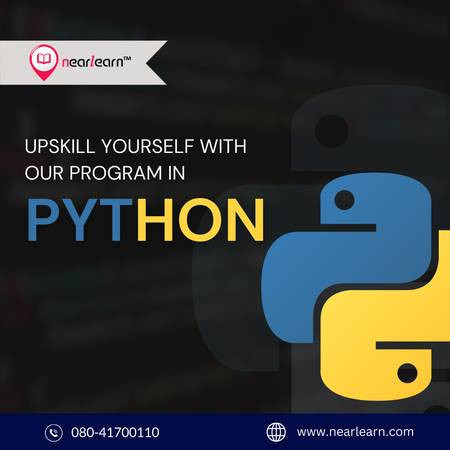Python Training Certification in Bangalore
Apr 25th, 2024 at 09:15 Learning Bengaluru 16 views Reference: 4984Location: Bengaluru
Price: ₹30,000
INTRODUCTION
Documentation in Python code is crucial for ensuring readability, maintainability, and collaboration within a project. Here are some best practices for effective Python code documentation@ www.nearlearn.com:
· Describe our code. ...
· Create docstrings for all public classes, methods, functions, and modules. ...
· Create appealing documentation with Sphinx
· Adopt a unified style. ...
· Incorporate illustrations in the writing. ...
· Describe limitations. ...
· Don't document internal information. ...
· Maintain a changelog…
By following these best practices, you can create Python code that is well-documented, easy to understand, and a pleasure to work with for both yourself and other developers.
You can always stop and review the resources linked here if you get stuck.
Top of Form
1. Your Environment for Building Documentation. ...
2. Create the Sample Python Package. ...
3. Write and Format Your Docstrings. ...
4. Prepare Your Documentation With MkDocs.
Best code documentation for python is :
Sphinx is far and away the most popular Python documentation tool. Use it. It converts reStructuredText markup language into a range of output formats including HTML, LaTeX (for printable PDF versions), manual pages, and plain text. There is also great, free hosting for your Sphinx docs@ www.nearlearn.com:
Certainly! Here's a comprehensive guide to best practices for documenting Python code:
1. Use Meaningful Variable and Function Names: Clear and descriptive names reduce the need for excessive comments by making the code self-explanatory.
2. Follow PEP 8 Guidelines: Adhere to the Python Enhancement Proposal (PEP) 8 style guide for consistent code formatting, including comments and docstrings.
3. Use Docstrings: Write docstrings for modules, classes, functions, and methods. Docstrings provide inline documentation that can be accessed via tools like help Use Triple Quotesfor Multiline DocstringsTriple quotes allow for multiline docstrings, enabling comprehensive documentation for complex functions or classes.
4. Follow the Google Style Docstring Format: Adopt the Google style docstring format for consistency and compatibility with popular documentation generators like Sphinx. This format includes sections such as "Args", "Returns", "Raises", and "Examples".
5. Document All Parameters and Return Values: Clearly document all parameters accepted by functions or methods, along with their types and purposes. Document the expected return values and their meanings.
6. Document Exception Handling: If a function raises exceptions under certain conditions, document those conditions and the types of exceptions that may be raised.
7. Provide Usage Examples: Include usage examples in your docstrings to illustrate how to use functions or methods effectively. Real-world examples help users understand the intended usage.
8. Update Documentation Regularly: Keep documentation up-to-date with code changes. Outdated documentation can mislead users and cause confusion.
9. Use Documentation Generators: Utilize documentation generators like Sphinx, Pdoc, or Doxygen to automate the generation of documentation from your codebase. These tools can produce professional-looking documentation in various formats.
10. Include Module-Level Documentation: Provide an overview of each module's purpose, contents, and usage at the beginning of the file. This summary helps users quickly grasp the module's functionality.
11. Document Class Interfaces: Document class interfaces, including methods, properties, and their purposes. Describe how to instantiate objects and interact with them.
12. Include Version Information: Specify the version of your code in the documentation. Users should know which version of the code they are referencing to ensure compatibility.
13. Document Public APIs Thoroughly: Document all public APIs extensively, including their parameters, return values, exceptions, and usage examples. Well-documented APIs facilitate easier integration and usage by other developers.
By following these best practices, you can ensure that your Python code is well-documented, easy to understand, and accessible to users and collaborators. Best institute in Bangalore is nearlearn visit our page https://nearlearn.com/python-online-training.














